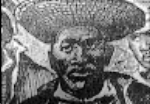Philip Reid: Difference between revisions
imported>David E. Volk (subpages, moving bibliography) |
imported>David E. Volk (move ext link to subpage) |
||
| Line 19: | Line 19: | ||
"... the facts are that [Freedom's] successful taking apart and handling in parts as a model was due to the faithful service and genius of an intelligent negro in Washington named Philip Reed (sic), a mulatto slave owned by Mr. Clark Mill, and that much credit is due him for his faithful and intelligent services rendered in modeling and casting America's superb Statue of Freedom, which kisses the first rays of the aurora of the rising sun as they appear upon the apex of the Capitol's wonderful dome." (Congressional Record (1928), 1200) | "... the facts are that [Freedom's] successful taking apart and handling in parts as a model was due to the faithful service and genius of an intelligent negro in Washington named Philip Reed (sic), a mulatto slave owned by Mr. Clark Mill, and that much credit is due him for his faithful and intelligent services rendered in modeling and casting America's superb Statue of Freedom, which kisses the first rays of the aurora of the rising sun as they appear upon the apex of the Capitol's wonderful dome." (Congressional Record (1928), 1200) | ||
Revision as of 16:01, 21 January 2008
Philip Reid was born a slave in the early 19th century at Charleston, South Carolina. Through an extraordinary turn of events he came to be a master craftsman and artisan, playing a key role in the completion of the United States Capitol at Washington D.C.
The Statue of Freedom, the crowning feature atop the dome of the U.S. Capitol, was hoisted into place on December 2, 1863. Commissioned in 1855, the full-size plaster model of Freedom was completed by Thomas Gibson Crawford in 1856 at his studio in Rome, Italy, and finally cast in Bronze at the Mills Foundry in Bladensburg, Maryland, ultimately under Philip Reid's supervision.
Philip Reid was purchased by Clark Mills, owner of the foundry that was awarded the contract to cast the plaster model in bronze. In April, 1858, the model left Rome in six crates aboard the Emily Taylor. Finally arriving at its Maryland destination, work began in May, 1860. When completed, the five one-ton sections of Freedom were transported by wagons from Bladensburg to Washington D.C.
Philip Reid and a team of laborers assembled the Statue of Freedom on site at the Capitol grounds in 31 days during the Spring of 1863. On December 2, 1863, the Statue of Freedom was hoisted to the top of the Capitol Dome amid great celebration and a 35-gun salute.
Approximately half of the artisans working on the nation's Capitol building between 1790 and 1863 were slaves, laboring in the quarries of Virginia, excavating and hauling the stone that would be used in the building's construction. They hauled lumber, dug trenches, and ultimately placed the cut stone on the walls of the building.
On April 16, 1862, President Abraham Lincoln signed an act abolishing involuntary servitude in the District of Columbia. This Emancipation Proclamation put an end to slavery within the capital city, and Philip Reid became a free man.
Notes
Yet amid the turmoil [between the states], work on Freedom continued. Arriving in pieces, she was cast at the Clark Mill's Foundry near Bladensburg, Maryland, under the care, ironically, of a mulatto slave. In an address to Congress 70 years later, a long-time admirer of Lady Freedom, William A. Cox, recalled the facts surrounding Freedom's construction:
"... the facts are that [Freedom's] successful taking apart and handling in parts as a model was due to the faithful service and genius of an intelligent negro in Washington named Philip Reed (sic), a mulatto slave owned by Mr. Clark Mill, and that much credit is due him for his faithful and intelligent services rendered in modeling and casting America's superb Statue of Freedom, which kisses the first rays of the aurora of the rising sun as they appear upon the apex of the Capitol's wonderful dome." (Congressional Record (1928), 1200)
Further Reading
- Randall Robinson, "The Debt: What America Owes to Blacks", Plume, January 2, 2001
- Dr. Eugene Walton, "The Biography of Philip Reid: Historical Fiction", published by Eugene Walton
